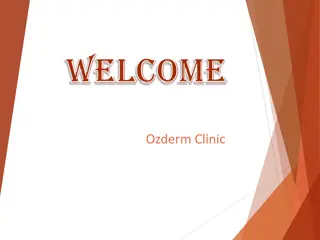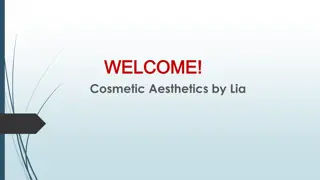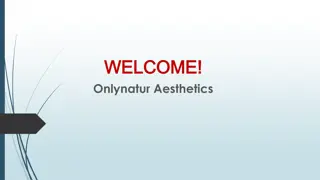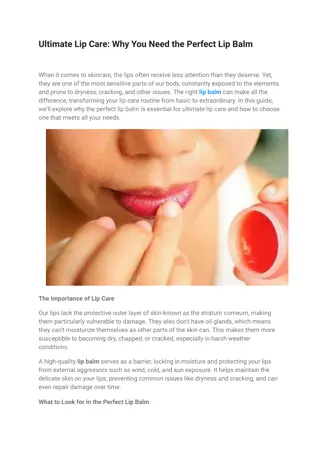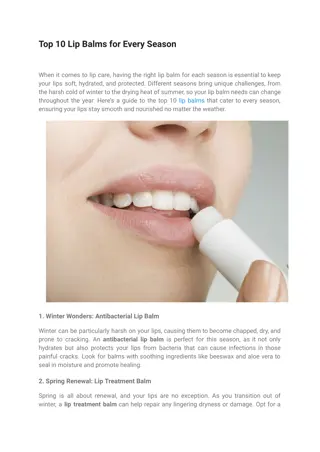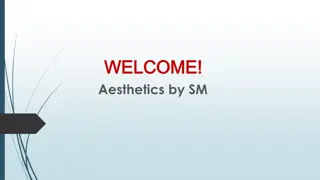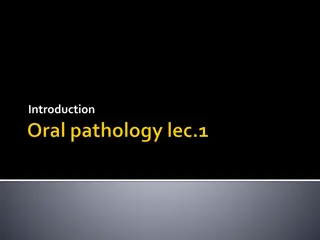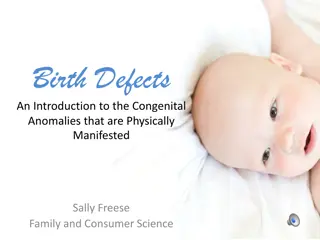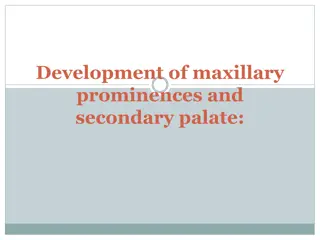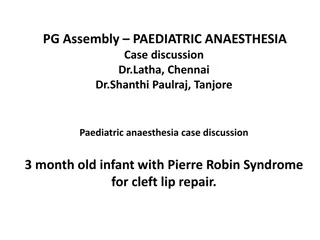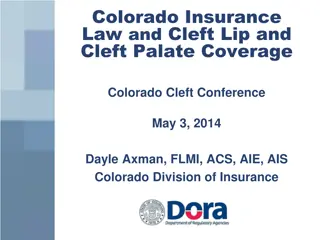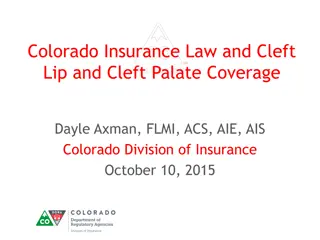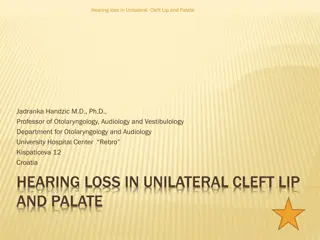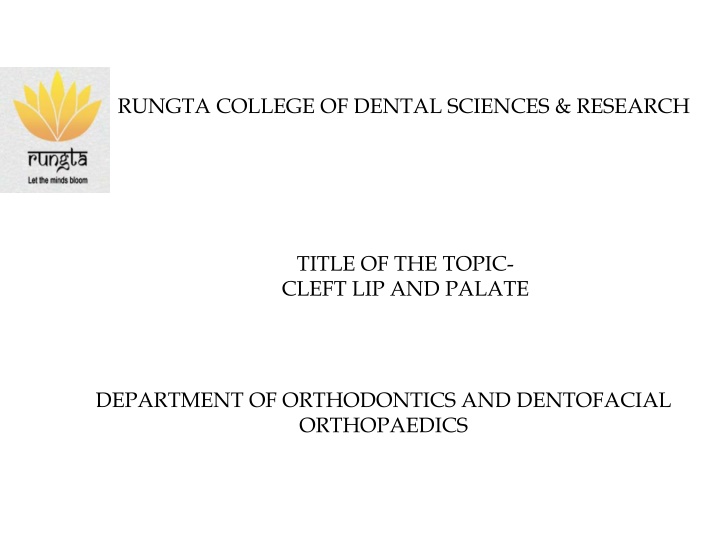
Cleft Lip and Palate: Research Insights and Management Strategies
Explore the comprehensive research on cleft lip and palate at Rungta College of Dental Sciences & Research. Learn about the incidence, embryological background, etiology, and management of this condition, along with specific learning objectives in orthodontics and dentofacial orthopedics.
Uploaded on | 0 Views
Download Presentation

Please find below an Image/Link to download the presentation.
The content on the website is provided AS IS for your information and personal use only. It may not be sold, licensed, or shared on other websites without obtaining consent from the author. If you encounter any issues during the download, it is possible that the publisher has removed the file from their server.
You are allowed to download the files provided on this website for personal or commercial use, subject to the condition that they are used lawfully. All files are the property of their respective owners.
The content on the website is provided AS IS for your information and personal use only. It may not be sold, licensed, or shared on other websites without obtaining consent from the author.
E N D
Presentation Transcript
RUNGTA COLLEGE OF DENTAL SCIENCES & RESEARCH TITLE OF THE TOPIC- CLEFT LIP AND PALATE DEPARTMENT OF ORTHODONTICS AND DENTOFACIAL ORTHOPAEDICS
Specific learning Objectives CORE AREAS DOMAIN CATEGORY INTRODUCTION AFFECTIVE DESIRE TO KNOW INCIDENCE AFFECTIVE DESIRE TO KNOW EMBRYOLOGY COGNITIVE NICE TO KNOW ETIOLOGY COGNITIVE MUST KNOW PSYCHOMOTOR CLASSIFICATION MUST KNOW COGNITIVE PROBLEM MUST KNOW PSYCHOMOTOR MANAGEMENT NICE TO KNOW
CONTENTS PART I Introduction Incidence Embryology Etiology & Predisposing factors Classifications PART II Classifications Problems associated with clefts Management Summary
INCIDENCE The reported incidence varies accordingly:- Geographic location Ethnicity Gender Socioeconomic status
The incidence is 1 in every 600-1000 births Least incidence- Negroids Highest incidence- Mongoloids Cleft lip common among Males Cleft palate common among Females
A.Unilateral cleft involving lip and alveolus. B.unilateral cleft involving lip and palate, C.bilateral cleft involving lip and palate D. median cleft involving palate only
ETIOLOGY OF CLEFT LIP AND PALTE ETIOLOGY MULTIFACTORIAL ETIOLOGY HEREDITY ENVIRONMENT
A.HEREDITY Cleft can be transmitted as a dominant or a recessive trait. Transforming growth factor alpha (TGFA) transforming growth factor beta 3 (TGFB3) AP2 and MSX1 are genes that plays major roles in the development of cleft lip cleft palate.
IDENTIFICATION OF SOME POTENTIAL GENES CAN BE DONE IN FOLLOWING WAYS:- LINKAGE ASSOCIATION ANIMAL MODELS
1.Linkage Linkage is a technique that allowa research to look for chromosome segments. Chromosome segment from affected family members are compared with the unaffected family member to look for share chromosome segment only in those with clefts. LIMITATION:- Limited no. of family member and even fewer affected population.
2.ASSOCIATION Association helps in understandind the developmental biology that is applied to identify which genes are expressed at different time in facial development, there by providing possible candidate genes.
3.ANIMAL MODELS Animals models often mice are an additional means of locating and testing candidate genes. Then coparisions have been made b/w the mouse and the human genome to look for a match.
B.ENVIRONMENT Envionmental factors that can increase the risk are divided into four categories:- 1.Womb environment 2.External environment 3.nutrition 4.drugs(teratogens):-antiepileptic drugs, retinoic acid, maternal smoking and alcoholism.
C.MULTIFACTORIAL ETIOLOGY Recent studies show that the etiology cannot be confined to either genetic or environmental factors. It seems to involve more than one factor.
PREDISPOSING FACTOR A no. of factors are believed to increase the risk of cleft lip and palate incidence. INCREASED MATERNAL AGE:- Women who concieve late have an increased risk of having an offspring with some form of clefting. The cause remains unknown. RACIAL:- Some races are more susceptible to cleft than others.Mongoloids show the greratest percentage of incidence.
BLOOD SUPPLY:- Any factor that reduce blood supply to the nasomaxillary area during embroyological decvelpment predisposes to cleft.
CLASSIFICATION OF CLEFT LIP AND PALATE. Davis and Ritchie classification 1922- Group 1:-Pre alveolar clefts:they are clefts involving only the lip and are sub classified as: -Unilateral -Bilateral -Median Group 2:-Post alveolar cleft:this group comprises of different degrees of hard and soft palate cleft that extends upto the alveolar ridge.
Group 3:-Alveolar cleft:they are complete cleft involving the palate,alveolar ridge and lip.They can be subdivided into: -Unilateral -Bilateral -Median
Vaeus classification 1931. -Group1: they are cleft involving the soft palate only. -Group2: they are cleft of the hard and soft plate extending upto the incisive foramen. -Group3: they are complete unilateral clefts involving the soft palate,hard palate,lip and alveolar ridge. -Group4: they are conplete bilateral cleft affecting the soft palate hard palate,lip and alveolar ridge.
SUMMARY Cleft lip and palate are congenital abnormalities that affect the upper lip and the hard and soft palate of the mouth. Three main types occur morphologically: 1. Cleft lip (CL) 2. Cleft lip and palate (CLP) 3. Isolated cleft palate (CP). The patient is afflicted by a number of problems associated with the functions performed by the oral and nasal cavities. Children born with cleft lip and palate have a number of problems that have to be solved for successful rehabilitation. The complexity of the problem requires that a number of specialists get together at various stages of development for the eventual betterment of the patient.
REFERENCES Textbook of Orthodontics Gurkeerat Singh, Jaypee Brothers; 2nd Edition Orthodontics The Art and Science, S.I Bhalajhi, AryaMedi Publishing; 7th Edition Textbook of Orthodontics Sridhar Premkumar, Elsevier; 1st Edition Orthodontics: Diagnosis and Management of Malocclusion and Dentofacial Deformities O.P Kharbanda, Elsevier; 1st Edition


